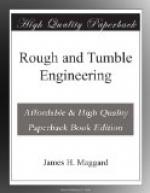on the crank shaft from which the governor is run
and you will probably find it loose. If the engine
has been run for any length of time, you will always
find the trouble in one of these places, but if it
is a new one the governor valve might fit a little
tight in the valve chamber and you may have to take
it out and use a little emery paper to take off the
rough projections on the valve. Never use a file
on this valve if you can get emery paper, and I would
advise you to always have some of it with you.
It will often come handy. Now if the engine
should start off at a lively gait and continue to
run still faster, you must stop at once. The
trouble this time is surely in the governor.
If the belt is all right, examine the jam nuts on
the top of the governor valve stem. You will probably
find that these nuts have worked loose and the rod
is working up, which will increase the speed of the
engine. If these are all right, you will find
that either a pulley or a little cog wheel is loose.
A quick eye will locate the trouble before you have
time to stop. If the belt is loose, the governor
will lag while the engine will run away. If the
wheel is loose, the governor will most likely stop
and the engine will go on a tear. If the jam
nut has worked loose, the governor will run as usual,
except that it will increase its speed as the speed
of the engine is increased. Now any of these
little things may happen and are likely to. None
of them are serious, provided you take my advice, and
remain near the engine. Now if you are thirty
or forty feet away from the engine and the governor
belt slips, or gets unlaced, or the pulley gets off,
about the first thing the engine would do would be
to jump out of the belt and by the time you get to
it, it will be having a mighty lively time all alone.
This might happen once and do no harm, and it might
happen again and do a great deal of damage, and you
are being paid to run the engine and you must stay
by it. The governor is not a difficult thing
to handle, but it requires your attention.
Now if I should drop the governor, you might say that
I had not given you any instructions about how to
regulate it to speed. I really do not know whether
it is worth while to say much about it, for governors
are of different designs and are necessarily differently
arranged for regulating, but to help young learners
I will take the Waters governors which I think the
most generally used on threshing and farm engines.
You will find on the upper end of the valve or governor
stem two little brass nuts. The upper one is
a thumb nut and is made fast to the stem. The
second nut is a loose jam nut. To increase the
speed of the engine loosen this jam nut and take hold
of the thumb nut and turn it back slowly, watching
the motion of your engine all the while. When
you have obtained the speed you require, run the thumb
nut down as tight as you can with your fingers.
Never use a wrench on these nuts. To slow or
slacken the speed, loosen the jam nut as before, except
that you must run it up a few turns, then taking hold
of the thumb nut, turn down slowly until you have
the speed required, when you again set the thumb nut
secure. In regulating the speed, be careful not
to press down on the stem when turning, as this will
make the engine run a little slower than it will after
the pressure of your hand is removed.




